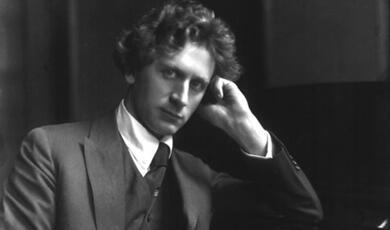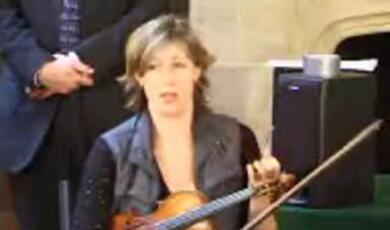Twentieth-Century Divas: Shirley Bassey
Share
- Details
- Text
- Audio
- Downloads
- Extra Reading
The Black Welsh singer started out recording cover versions of American songbook classics but rose to international fame after her performance of the title song of Goldfinger. Movie songs, successful albums and popular television specials followed, but so too did personal tragedy and a highly critical (and gendered) reputation of her professional behaviour in the media.
The word ‘diva’ has been applied both admiringly and misogynistically to her life and work, typifying her experience as a Black British woman.
Download Text
Twentieth-Century Divas: Shirley Bassey
Dominic Broomfield-McHugh
Visiting Professor of Film and Theatre Music
21 March 2024
Prelude: Goldfinger
The opening bars of John Barry’s iconic title song for the James Bond film Goldfinger evoke the spirit of another time. 2024 marks the sixtieth anniversary of the movie itself, with its first-ever outing for the Aston Martin, its overblown villain and stereotypical sidekick, and footage of the premiere in Leicester Square reveals how the Bond frenzy had taken over London in the mid-1960s. Rewatching the film today, much of its original power seems to have lost, though its stylishness remains.
However, the film has an enduring legacy thanks to the remarkable power of Shirley Bassey’s performance of the title song over the opening titles. In the lecture, we’ll look at Leslie Bricusse’s sketchbook for the lyrics of the song (housed at the Library of Congress), which were written some months after John Barry had composed the music. Bricusse and his co-lyricist Anthony Newley inherited the melody from Barry, which meant they knew what the structure of the words needed to be. The imagery and specific word choices, however, were harder to come by. The song has been central to Bassey’s career, not only because of its commercial success (it reached no. 1 in the USA) but because it provides the ideal vehicle, vocally and in terms of content, for her ability to belt and her cheeky sexuality. But comparing a 1974 performance with one from 1997 reveals that it took some time for her diva personality to be established.
Early Shirley
Born into a working-class family in Tiger Bay, Bassey grew up in a Welsh port that was unusually multiracial for the time. Her father was Nigerian, her mother from Yorkshire; her father was deported when she was still a small child and her mother moved her with her six siblings to the town of Splott. Dame Shirley’s mixed heritage is sometimes played down in the reception of her career but it’s clear from articles and reviews written about her early appearances that there was a significant focus on her heritage and skin colour. And her stage debut was in a second-rate variety show called Memories of Jolson, in which the lead performer appeared in blackface in homage to the American singer Al Jolson.
Bassey was a teenager when she started to perform professionally and gave birth to a daughter, Sharon, who was initially raised by Bassey’s sister. For some years, Dame Shirley was compared to longer-established performers including Lena Horne and Judy Garland – not always favorably, but most people seemed to agree that she had talent if only it could gain some focus.
‘Finding’ Shirley
Recordings from the first ten or so years of her career show experiments in different kinds of repertoire. She performed a lot of American Songbook classics by Cole Porter et al, and also had some generic numbers written specially for her (e.g. ‘Burn My Candle (At Both Ends)’, which was banned by the BBC though she performed it on television when she was still only nineteen years old). One of her most striking recordings is from 1962: a rendition of the Bach-Gounod ‘Ave Maria’ that shows she could sing in head voice (i.e. with a more classical sound).
But a scrutiny of her catalogue appears to indicate that it was sometime during 1963 to 1964 that her iconic approach to songs, with a heightened sense of drama, emerged. Strikingly, the recording that really shows that this richer vocal sound and more assertive interpretative approach had been established is ‘I (Who Have Nothing)’ from 1963, the first recording she made with George Martin, famous in this period as The Beatles’ producer. A year later came ‘Goldfinger’, and she became a star across the western world.
Mythologising Bassey
Something that has surprised me in preparation for this lecture is how little is really known about the details of Dame Shirley’s life. Although the key facts and incidents are well documented, her interviews have tended to focus on promoting certain albums and discussing only some aspects of her experience. The three main publications about her – by Muriel Burgess (1998), Peter Hogan (2008) and John L. Williams (2010) – each offer some new material but there is a lot of dramatizing and mythologizing. There is also considerable reliance on the memoirs of Michael Sullivan, her first proper agent and the man who took her from the Jolson star and paved the way for solo appearances as London’s prestigious Talk of the Town and Café de Paris, not to mention television. In the book, Sullivan’s attitude to Bassey is often shockingly insensitive and even dehumanizing. The reliance on his narrative by her biographers makes it difficult to see her rise to fame with total clarity.
Vocal Crisis
In September 1985, Bassey’s second daughter Samantha was found dead. The trauma affected Dame Shirley’s voice, which gave out during her annual tour to Australia, where she has been particularly popular. Bassey has been open about having taken a year to train with the vocal coach Helena Shenel, who was herself a trained opera singer. This process of retraining around her fiftieth birthday has arguably made her voice both more exciting and facilitated her remarkable longevity: even beyond her eightieth birthday she was capable of providing vocal thrills, such as at the Bruce Forsyth tribute at the London Palladium in 2018.
Reinventions
Another dimension of Bassey’s longevity is her willingness to reinvent herself, albeit while retaining aspects of her diva presentation. She did this as early as 1970 with her hugely successful Something album, in which she covered songs by contemporary songwriters such as George Harrison and Michel Legrand, as well as a number from the rock musical Hair. The key period for her in this respect, though, was 1997-2007, spanning the decade between her 60th and 70th birthdays. She appeared on a single by the electronic music duo Propellerheads, ‘History Repeating’ (1997), and later covered Pink’s ‘Get the Party Started’, which was released as a James Bond spoof video for the M&S Christmas advert in 2006. She also released The Remix Album, in which various DJs sampled some of her greatest hits. This willingness to engage with contemporary pop while still showcasing her diva voice and frocks has helped her to endure and access new generations, even if some of the work is not successful.
The Diva’s Sense of Humour
Another aspect of her winning formula is the projection of Dame Shirley’s sense of humour into her work. She has spoken in interviews about how she thought she was supposed to be actively difficult to deal with earlier in her career but had later recognized the need to apologise if she caused offence (several documentaries of her in rehearsal certainly show her getting stressed or frustrated). To balance out her formidable performances, she has appeared with a number of comedians and has shown herself to be able to embrace self-parody: perhaps this started with her iconic appearance in The Morecambe and Wise Christmas Special in 1971, but it continued through television appearances with figures such as Les Dawson too. This has enriched her star text.
Ageing: Big Spender
Longevity has also been facilitated by ‘managing’ her ageing through her concert appearances. She has always been meticulous in her dress, wigs and make-up, which have assisted in making her a consistently striking figure on the stage. But her interpretations of her back catalogue have often been thoughtful in terms of handling how to keep performing the same songs, arrangements and routines over four or more decades. In the lecture, we’ll consider excerpts from four televised performances of her hit ‘Big Spender’: 1974 (playful but not yet a diva), 1996 (abandoning parts of the text to jokingly show off her impressive physique), 2007 (joking about running out of breath at Glastonbury) and 2009 (a formidable rendition, aged 72, at the trendy Electric Proms). She’s known that to continue singing the same material, she has needed to modify her relationship to the material.
The perception of the autobiographical
More than anything, the power of Dame Shirley’s performances is the way she has given the impression that her work – or at least her most striking work – is about her. The public knowledge of her deprived background, the death of her daughter and her vocal crisis (to give just three examples) has been part of some of her song choices. Quite a few of these songs have lyrics that are a bit absurd or don’t mean very much: she has made a career of singing lines such as ‘For a golden girl knows when he’s kissed her / It’s the kiss of death from Mr. / Goldfinger’. Yet in interviews or concert commentaries, she often explains how much her singing means to her, and her choice of numbers such as the gay anthem ‘I Am What I Am’ and the San Remo festival song ‘This Is My Life’ has given her diva stardom an extra charge. For while her songs of suffering or of triumphing over adversity may not actually be about her, the power of Dame Shirley Bassey’s voice and gestures make us believe that it’s real. And this leap from the obviously-constructed (i.e. her song lyrics) to the personal (i.e. the authenticity of her performances) has helped her to become not only commercially enduring but also a national treasure, most recently celebrated in a special coin released by Royal Mint and in her rise to Companion of Honour in the New Year Honours.
© Professor Dominic Broomfield-McHugh 2024
References and Further Reading
Bassey, Shirley. My Life on Record and in Concert. Bloomsbury. 1998.
Burgess, Muriel. Shirley: An Appreciation of the Life of Shirley Bassey. Random House. 1998.
Hogan, Peter. Diamond Diva. Andre Deutsch. 2008.
Sullivan, Michael. There’s No People Like Show People: Confessions of a Showbiz Agent. Quadrant. 1984.
White, Chris and Penna, Tristram. Bassey: The EMI/UA Years. 1994.
Williams, John L. Miss Shirley Bassey. Quercus. 2010.
© Professor Dominic Broomfield-McHugh 2024
References and Further Reading
Bassey, Shirley. My Life on Record and in Concert. Bloomsbury. 1998.
Burgess, Muriel. Shirley: An Appreciation of the Life of Shirley Bassey. Random House. 1998.
Hogan, Peter. Diamond Diva. Andre Deutsch. 2008.
Sullivan, Michael. There’s No People Like Show People: Confessions of a Showbiz Agent. Quadrant. 1984.
White, Chris and Penna, Tristram. Bassey: The EMI/UA Years. 1994.
Williams, John L. Miss Shirley Bassey. Quercus. 2010.
Part of:
This event was on Thu, 21 Mar 2024
Support Gresham
Gresham College has offered an outstanding education to the public free of charge for over 400 years. Today, Gresham College plays an important role in fostering a love of learning and a greater understanding of ourselves and the world around us. Your donation will help to widen our reach and to broaden our audience, allowing more people to benefit from a high-quality education from some of the brightest minds.


 Login
Login







